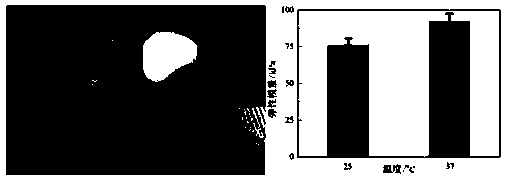Preparation method of quick dissociative type thermosensitive hyaluronic acid hydrogel
A hyaluronic acid, temperature-sensitive technology, applied in the field of biomedical materials, can solve the problems of unsatisfactory hydrogel uniformity, stability and durability, unable to meet the needs of rapid cell-matrix separation, etc., and achieve flexible control of pore size Narrow size, pore size distribution, and strong controllability
- Summary
- Abstract
- Description
- Claims
- Application Information
AI Technical Summary
Problems solved by technology
Method used
Image
Examples
Embodiment 1
[0031] 1) First, dissolve hyaluronic acid with a molecular weight of 300,000 in high-purity water to prepare a hyaluronic acid solution with a mass concentration of 4%;
[0032]2) Next, add 50% of the mass of hyaluronic acid to the solution, which is a temperature-sensitive macromolecular cross-linking poly(N-isopropylacrylamide) with a molecular weight of 20,000 and a narrow molecular weight distribution containing disulfide bonds and double-terminal amino groups. After the joint agent is stirred and dissolved, adjust the pH value to 5 with hydrochloric acid or NaOH solution;
[0033] The temperature-sensitive macromolecular crosslinking agent of poly(N-isopropylacrylamide) of narrow molecular weight distribution containing disulfide bonds and double-terminal amino groups is synthesized by the following steps:
[0034] a) Add chain transfer agent S,S'-bis(α,α'-methyl-α"-acetic acid) trithiocarbonate in sequence in anhydrous and oxygen-free organic solvent 1,4-dioxane, mono B...
Embodiment 2
[0040] 1) First, dissolve hyaluronic acid with a molecular weight of 50,000 in high-purity water to prepare a hyaluronic acid solution with a mass concentration of 3%;
[0041] 2) Next, add 30% of the mass of hyaluronic acid to the solution, which is a temperature-sensitive macromolecular cross-linking poly(N-isopropylacrylamide) with a molecular weight of 50,000 and a narrow molecular weight distribution containing disulfide bonds and double-terminal amino groups. After the joint agent is stirred and dissolved, adjust the pH value to 5.5 with hydrochloric acid or NaOH solution;
[0042] The temperature-sensitive macromolecular crosslinking agent of poly(N-isopropylacrylamide) of narrow molecular weight distribution containing disulfide bonds and double-terminal amino groups is synthesized by the following steps:
[0043] a) Add chain transfer agent S,S'-bis(α,α'-methyl-α"-acetic acid) trithiocarbonate and monomer N-isopropylpropene to tetrahydrofuran, an anhydrous and oxygen-...
Embodiment 3
[0048] 1) First, dissolve hyaluronic acid with a molecular weight of 200,000 in high-purity water to prepare a hyaluronic acid solution with a mass concentration of 4%;
[0049] 2) Next, add 60% of the mass of hyaluronic acid to the solution, which is a temperature-sensitive macromolecular cross-linking poly(N-isopropylacrylamide) with a molecular weight of 30,000 and a narrow molecular weight distribution containing disulfide bonds and double-terminal amino groups. After the joint agent is stirred and dissolved, adjust the pH value to 4 with hydrochloric acid or NaOH solution;
[0050] The temperature-sensitive macromolecular crosslinking agent of poly(N-isopropylacrylamide) of narrow molecular weight distribution containing disulfide bonds and double-terminal amino groups is synthesized by the following steps:
[0051] a) Add chain transfer agent S,S'-bis(α,α'-methyl-α"-acetic acid) trithiocarbonate in sequence in anhydrous and oxygen-free organic solvent 1,4-dioxane, mono ...
PUM
 Login to View More
Login to View More Abstract
Description
Claims
Application Information
 Login to View More
Login to View More - R&D
- Intellectual Property
- Life Sciences
- Materials
- Tech Scout
- Unparalleled Data Quality
- Higher Quality Content
- 60% Fewer Hallucinations
Browse by: Latest US Patents, China's latest patents, Technical Efficacy Thesaurus, Application Domain, Technology Topic, Popular Technical Reports.
© 2025 PatSnap. All rights reserved.Legal|Privacy policy|Modern Slavery Act Transparency Statement|Sitemap|About US| Contact US: help@patsnap.com



